Thanks to Viking River Cruises for inviting us along and providing this adventure! As always, all opinions are our own.
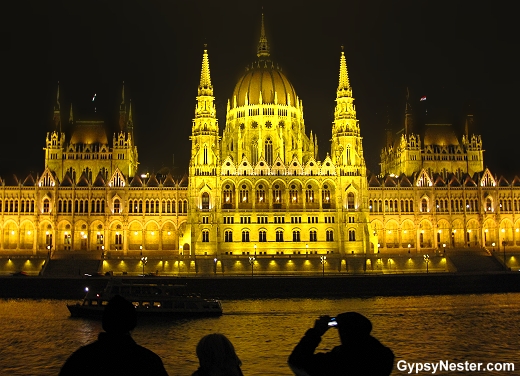
Budapest is truly a tale of two cities, Buda and Pest, separated by the Danube River. Since the Viking Longship Skadi that would serve as our hotel for the next couple of days was docked on the Pest side of the river, we set out to explore what’s called the “New City” first.
Prowling Pest
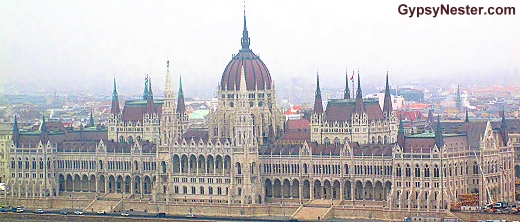

New, as is often the case in Europe, can be a relative term, Pest is around one thousand years old.
Although in this case the reference is to the government and business districts which are more modern.
Perhaps the most striking of these is the Parliament House, overlooking the river.
When the two cities united in 1873 to form the capital of Hungary, it was decided that a grand new building was needed to house the legislature. A competition was held to pick a design and in 1885 construction began. The building was dedicated on the 1000th anniversary of the country in 1896, and finally completed in 1904.
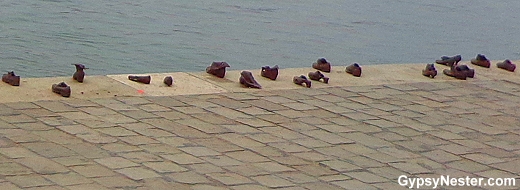
Along the water in front of Parliament House there is a poignant memorial to the Jewish people of Budapest who perished at the hands of the Nazi-affiliated Arrow Cross during World War II.
Shoes on the Danube represents how people were lined up on the river bank and shot into the water so the current would carry their bodies away. But first they were ordered to remove their shoes because the footwear was considered too valuable to be lost in the river. Sculptor Gyula Pauer created sixty pairs of iron shoes to commemorate the victims.
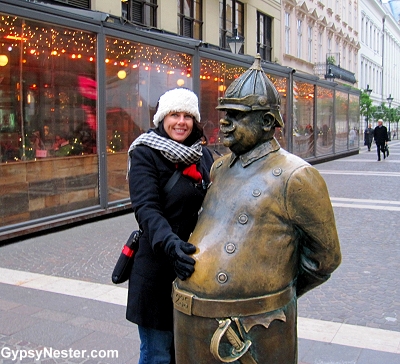
Walking away from the river toward St. Stephen’s Basilica we came upon a much more lighthearted piece of artwork.
This bronze Hungarian policeman from the early 1900s keeps an eye on Zrínyi utca (Zrínyi Street).
Veronica seemed to think his belly needed a pat.
A King and a Saint? What a guy!
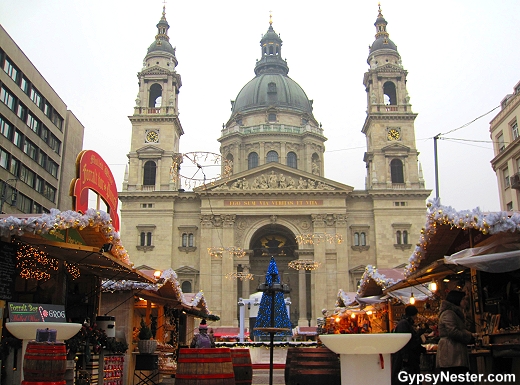
The small Christmas Market in front of St. Stephen’s Basilica
Szent István Bazilika, Saint Stephen’s, serves as the main church for Budapest. It is named for Saint Stephen I of Hungary, who tradition says became the country’s first King on Christmas in the year 1000. He was canonized in 1083 by Pope Gregory VII for bringing Christianity to Hungary.
The church is quite new compared to most of the great cathedrals of Europe, completed in 1905 after fifty-four years of construction.
Without really knowing what to expect, we bought tickets to go up in the tower. Climbing the seemingly endless stairs, we were feeling certain that there must be something really good at the top. Three hundred sixty four steps later we were not disappointed.
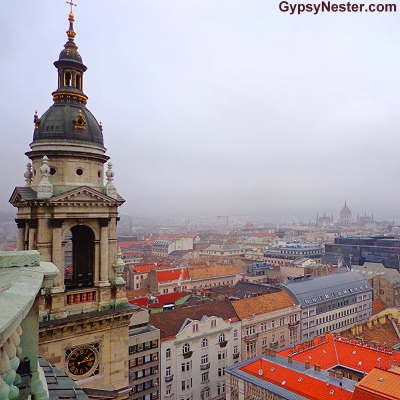
From the top of the cathedral dome we had a 360 degree panoramic view of the entire city. It looked to be the highest spot in town, but we discovered later that the dome on the parliament building is the exact same height.
This was done intentionally, to show the equality of political and religious power. By law, no building can be erected higher than the ninety-six meters of these two domes.
Inside the basilica, the king who became the patron saint of Hungary is honored in several ways, including a display of his right hand.
Yes, the one thousand year old mummified hand of Saint Stephen is kept in a glass case in a small chapel at the back of the church.
We know this to be true because we saw it with our own eyes. Just slip a coin into a slot and a light comes on to reveal it, looking like it had the worst case of frostbite ever. We had to get out of there.
The Architecture of Pest
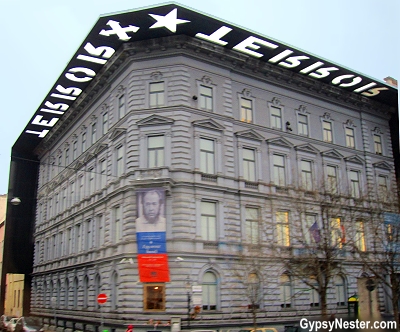
In order to see more of the Pest side in our limited time we took a quick bus tour that hit several of the highlights. Many of the city’s landmarks line Andrássy Avenue, along with the homes of prominent residents, so that was where we began.
We passed the scariest building we’ve ever seen, the House of Terror, which served as the headquarters for the secret police of both the Arrow Cross Nazi and Communist regimes but now is a museum…
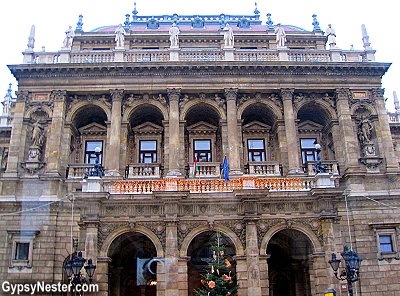
… and the Hungarian State Opera House, that has been going strong since 1884.
At the end of the avenue we made a circle around Hősök tere, Heroes’ Square, the city’s main plaza.
The center of the square features the Millennium Monument, built in 1896 to commemorate the thousandth anniversary of the founding of Hungary.
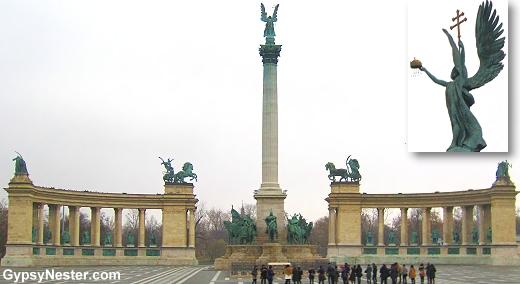
Statues of the leaders of the seven Magyar tribes that arrived in the late 9th century from Asia are depicted on one side of the main column, and more modern Hungarian heroes on the other. The column is topped with the archangel Gabriel holding a replica of the royal crown.
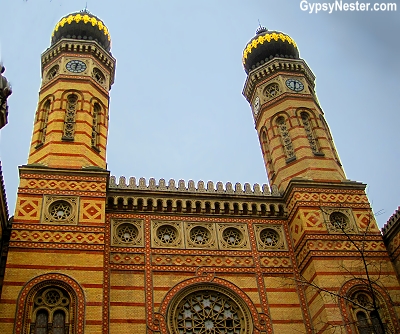
On our way back through town we went by the Dohány Street Synagogue. This is the largest synagogue in Europe, and the third largest in the world.
We couldn’t help noticing stark variations and contrasts between many of the buildings throughout the city.
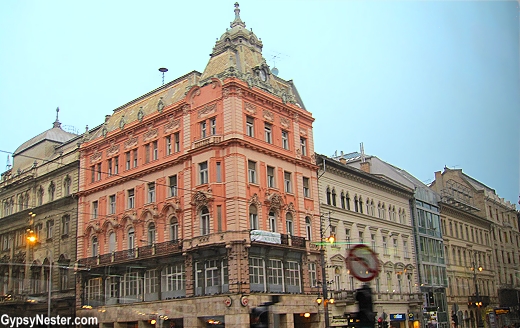
Some have been renovated and look stunning, while others still show evidence of heavy damage from WWII or years of neglect under communist rule.
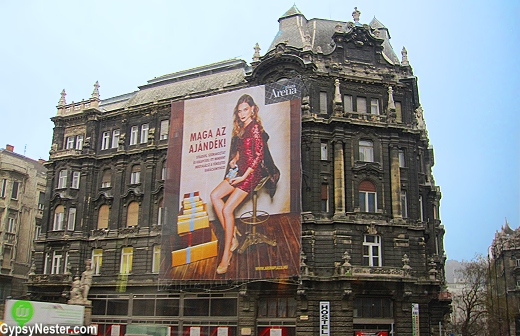
Happily, signs of ongoing renovation of these beautiful buildings are everywhere.
Checking out the Christmas Market
To finish our day in Pest we checked out the the city’s main Christmas market, a large collection of stands and kiosks all decked out in holiday style.
We were surprised how many of these were selling food or drink as opposed to gifts. It seemed that this market was more of a gathering place for friends and family to grab a bite, hang out, socialize, and listen to music than a shopping venue. Basically a street fair, so we loved it.
We started with a cup of forralt bor, meaning boiled wine, the Hungarian version of mulled wine, or glühwein.
With our cockles properly warmed we were ready to sample some of the local fare.
See more photos of Budapest’s bustling Christmas Market!
Everything looked fantastic but we settled on töltött káposzta, cabbage stuffed with meat and rice and served with a paprika sauce and sour cream, then we added a huge smoked meat dumpling with sauerkraut to our meal.
Exceedingly Hungarian!
See more photos of Budapest’s bustling Christmas Market!
Buda
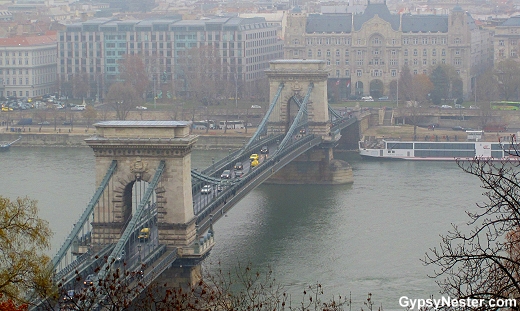
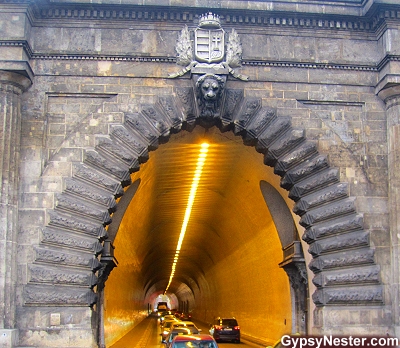
The next morning found us crossing the Chain Bridge, the most famous of the eight bridges that span the Danube between Buda and Pest.
The picturesque suspension bridge was the first permanent bridge across the river when it opened in 1849.

Above the bridge, the domed Buda Castle dominates the valley from its perch on Castle Hill.
Rulers and royals resided on the spot for nearly 700 years. These days, it houses a collection of museums.
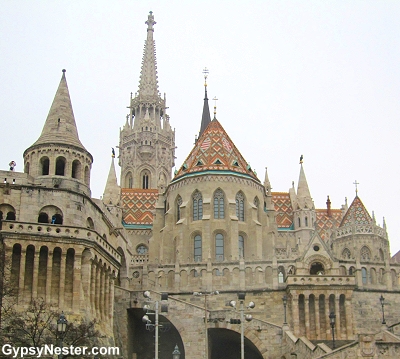
The area around the castle is like a village in itself, mostly contained within the Fisherman’s Bastion.
As with Hero’s Square and the Parliament House, the bastion was built at the time of the millennial celebration.
Although it looks like a fortress, it was made more as a monument and scenic overlook, with seven towers to represent the seven Magyar tribes that came to the area in 896.
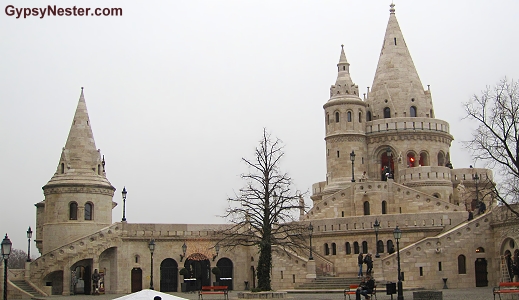
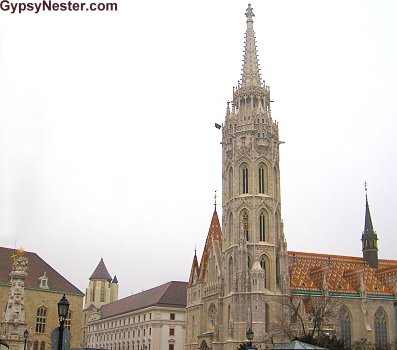
Within the bastion walls the Matthias Church serves as the second most important church in Budapest. A church has been on this spot for around a thousand years, built and rebuilt several times.
It even served as a mosque during the Ottoman rule over Hungary. We’ve learned that many churches were converted under the Ottoman Empire. The current design, from renovations just over a century ago, is in a Byzantine style that reflects the eastern heritage of the Hungarian people.
Follow us into the gorgeous Matthias Church
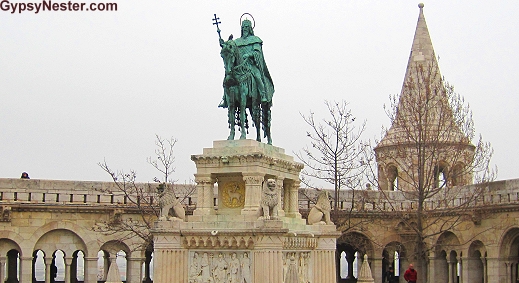
Outside the church we once again found King, or should we say Saint, Stephen immortalized, this time mounted on his trusty steed amid the fortifications of the bastion.
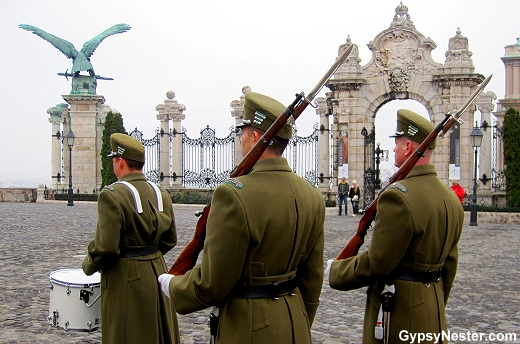
Following the walls back toward the castle we happened to wander up just in time to see the changing of the guard at Sándor Palace, which now serves as the presidential palace. It was heavily damaged, along with most of the buildings on the hill, by Allied bombers in 1944 and wasn’t rebuilt until after the fall of communism in 1989.
Eating Like a Hungarian: Getting Goulash

On our way back to Skadi the chill was starting to set in again when we spotted a sign advertising the oldest restaurant in Pest.
We couldn’t pass that up, and some steaming hot soup sounded like just the ticket. The little basement dining area looked authentic enough, definitely old, if not the oldest, and proudly offered many traditional dishes.
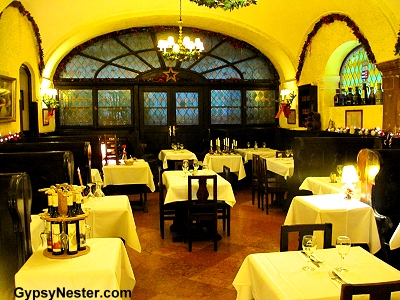
Goulash and fish soup are both classic, typical Hungarian dishes, and what better place to try them the the self-proclaimed oldest restaurant in town?
The name 100 Éves Etterem, One Hundred Years Old Restaurant, doesn’t really tell the whole story since it was adopted upon the establishment’s centennial in the 1930s.
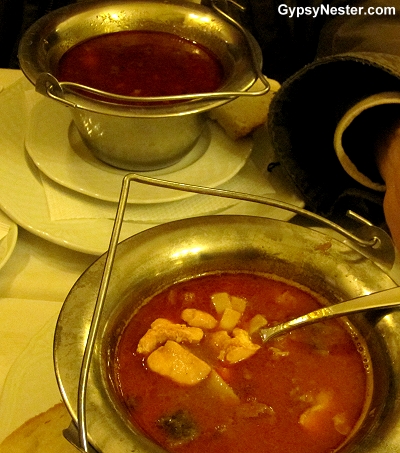
One hundred eighty years old would be more accurate, but hey, they can’t go changing the name every year now can they?
No matter, a soup by any other name would taste just as Mmmm, Mmmm, good.
Both were heavy on the paprika, this is Hungary after all, and served piping hot in pewter pots.
The goulash was full of meat, potatoes, and carrots, and the fish soup had big chunks of fish with hearty noodles.
A Magical Send Off
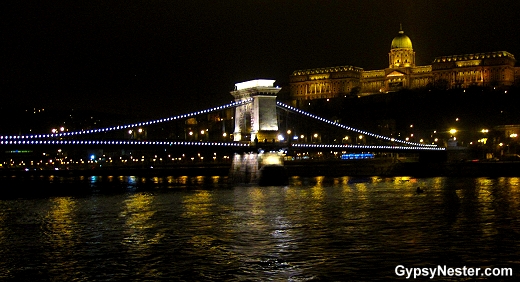
We were feeling pretty warm and fuzzy, but had to get back to the ship for what turned out to be the highlight of our entire stay in Budapest, leaving.
No kidding, the cruise up the river in the dark gave us an incredible nighttime view of the bridges and landmarks.
On the Buda side, the castle and Fisherman’s Bastion stood out like fireworks lit against the night sky.

While over on the Pest side of The Danube, The Parliament Building was absolutely stunning, glowing in the foggy darkness.
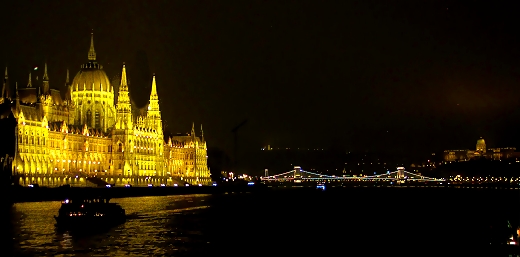
That fond farewell left memorable imprints on our minds after two remarkable days in Budapest, and an indelible desire to return someday… when it’s warmer.
David & Veronica, GypsyNester.com
Delve deeper:
Explore the St. Stephen’s Basilica
Check out the bustling Budapest Christmas Market
Discover more about
Fisherman’s Bastion & Matthias Church
Thanks to Viking River Cruises for inviting us along and providing this adventure! As always, all opinions are our own. See our entire Christmas cruise along The Danube with stops in Budapest, Bratislavia, Vienna, Durnstein & Melk, Linz & Salzburg, and Passau.


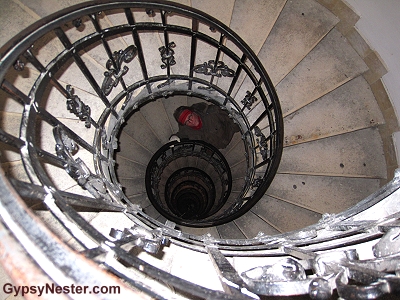
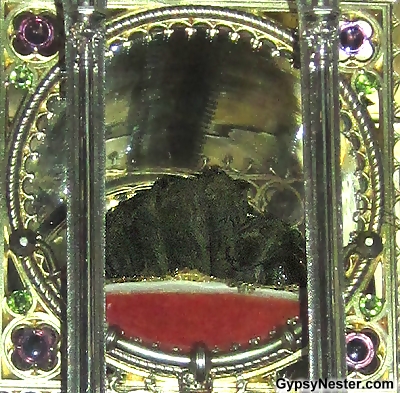
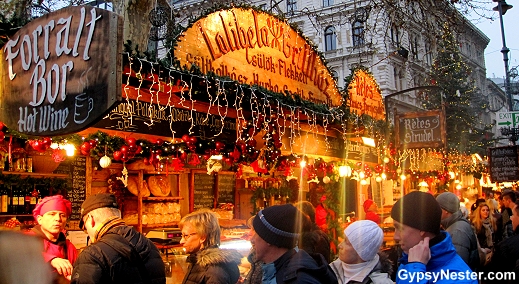
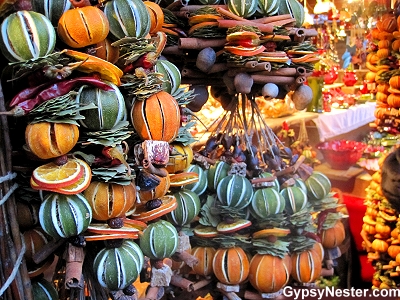
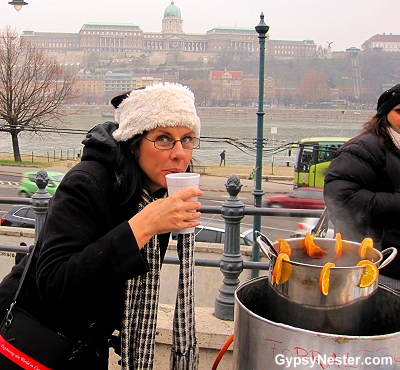
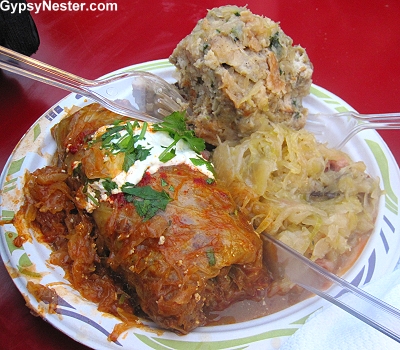

Lithuania Poland
Budapest is our favorite European city! We just love it because there is so much to do there. I could totally see myself living there.
It’s very cool!
Both Franca and I loved our brief stay in Budapest in 2012 and both sides of the river are filled with character that we can’t really decide which one we prefer more!
Too hard to choose.
You got that right! Both sides have their charms and together make for one great city.
Fantastic post! We’ll be visiting Budapest this summer. Just had a contributor write a Guide to Budapest on our site, hope it’s ok if I link this post to the guide? http://bbqboy.net/budapest-guide-travel-tips/
Frank (bbqboy)
Thanks Frank, no problem always glad to have more information.
Just a small correction: techincally 3 cities united in 1873 to form Budapest. They were Buda, Pest and Obuda (old Buda).
Thanks Sylvia, always glad to get better information.
My wife and I are heading over this spring. To see not only Budapest but the rest of Hungary as well. Cannot wait!!!
Have a great trip Steve!
Amazing post! I was just in Budapest a year ago and did most of these things. After reading this, I can’t wait to go back!
Cheers and happy travels 😉
Drew
Thanks Drew, we really want to go back to explore some more too.
I love how you experienced the city as two separate parts! It was very creative. I’m glad you enjoyed it. It is beyond beautiful. Thanks for sharing.
Thanks Mary, from what we saw the two side are really quite unique.
Love Buda and Pest! We went in the winter, too…sooooo cold! I needed some of that gluhwein!
Awesome pictures. I adore Budapest and have been there many times. Thank you for the sweet reminder of my beloved city.
Thanks Cheryl, glad to bring back fond memories.
Hanging out for visit Budapest! That parliament building is incredible
It really is, especially at night.
Budapest’s a beautiful city(or two), it’s one I must get to when I make a return to Europe.